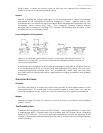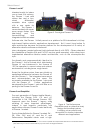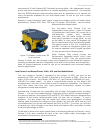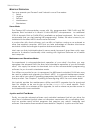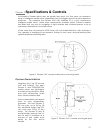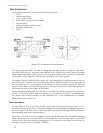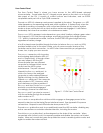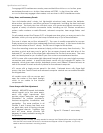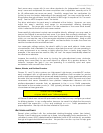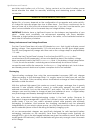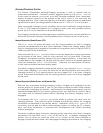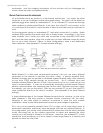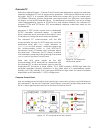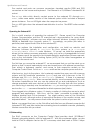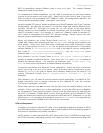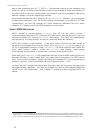
ActivMedia Robotics
Each sonar array comes with its own driver electronics for independent control. Each
array’s sonar are multiplexed; the sonar acquisition rate is adjustable, normally set to 25
Hz (40 milliseconds per sonar per array). Sensitivity ranges from ten centimeters (six
inches) to over four meters, depending on the ranging rate. You may control the sonar’s
firing pattern through software, too; the default is left-to-right in sequence 0 to 7 for each
array. See the AROS chapters 6 and 7 for details.
The driver electronics for each array is calibrated at the factory. However, you may
adjust the array’s sensitivity and range to accommodate differing operating
environments. The sonar gain control is on the underside of the sonar driver board,
which is attached to the floor of each sonar module.
Sonar sensitivity adjustment controls are accessible directly, although you may need to
remove the Gripper to access the front sonar, if you have that accessory attached.
8
For
the front sonar, for instance, locate a hole near the front underside of the array through
which you can see the cap of the sonar-gain adjustment potentiometer. Using a small
flat-blade screwdriver, turn the gain control counterclockwise to make the sonar less
sensitive to external noise and false echoes.
Low sonar-gain settings reduce the robot’s ability to see small objects. Under some
circumstances, that is desirable. For instance, attenuate the sonar if you are operating in
a noisy environment or on uneven or highly reflective floora heavy shag carpet, for
example. If the sonar are too sensitive, they will “see” the carpet immediately ahead of
the robot as an obstacle.
Increase the sensitivity of the sonar by turning the gain-adjustment screw clockwise,
making them more likely to see small objects or objects at a greater distance. For
instance, increase the gain if you are operating in a relatively quiet and open
environment with a smooth floor surface.
Motors, Wheels, and Position Encoders
Pioneer 2’s and 3’s drive systems use high-speed, high-torque, reversible-DC motors,
each equipped with a high-resolution optical quadrature shaft encoder for precise
position and speed sensing and advanced dead-reckoning. Motor gearhead ratios and
encoder ticks per revolution vary by robot model. However, AROS converts most client
commands and server information from platform independent distance units into
platform-dependent encoder ticks, as expressed in the Ticksmm FLASH parameter,
calculated as the encoder counts (4 * 500, typically) divided by the product of wheel
circumference times gear ratio.
Inflate the tires evenly
or your robot won’t drive properly.
All Pioneer 3 robots now come with pneumatic tires so that you may configure your robot
for differing terrains. In any configuration, however, be careful to inflate the tires evenly
and adjust the respective Ticksmm and rotational Revcount FLASH parameters for
proper operation. We ship with the tires inflated to 23 psi each.
BATTERIES AND POWER
Except when outfitted with the automated docking/charging system (see below),
Pioneer 2 and 3 robots may contain up to three, hot-swappable, seven ampere-hour, 12
volts direct-current (VDC) sealed lead/acid batteries (total of 252 watt-hours), accessible
through a hinged and latched rear door. We provide a suction cup tool to help grab
8
It’s easier to remove the DXE’s Nose with Gripper attached.
15



